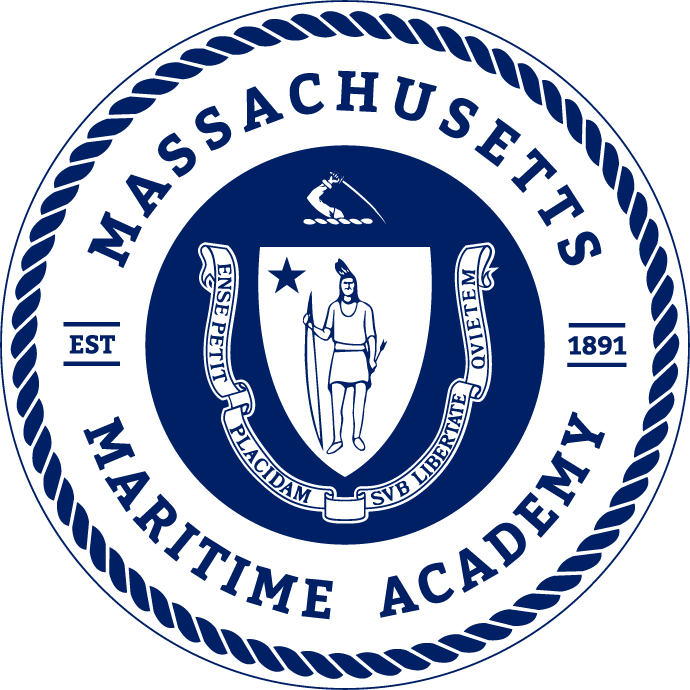Course Description
A capstone assessment program allowing deck, undergraduate students an opportunity to demonstrate competency in Bridge Resource Management and Watchstanding for STCW and USCG licensing requirements. Students successfully completing these competencies are capable of undertaking all of the duties and responsibilities expected of a deck watchkeeping officer. Upon successful completion of this course, a U.S. Coast Guard approved certificate is issued certifying that the holder demonstrates appropriate competence in watchkeeping, bridge team management, and bridge resource management, meeting the standards prescribed by IMO/STCW and the U.S. Coast Guard. [Lab time required]
This course consists of one 1-1/2-hour lecture and one 4 hour lab per week with practical assessments and a comprehensive final examination.
Entrance requirements
As per USCG, Academy and Marine Transportation Department requirements, any student enrolled in this course must have previously successfully satisfied the following prerequisites:
- MT 3231 Applied Shiphandling (Grade of 60 or better)
- MT 3222 ARPA (Grade of 70 or better and all ARPA assessments completed)
STCW Objectives
Demonstrate knowledge and understanding of the following STCW elements:
- OICNW-A2.2 Thorough knowledge of the Principles to be observed in keeping a navigational watch
- OICNW-A2.4 The use of information from navigational equipment for maintaining a safe navigational watch
- OICNW-A2.6 The use of reporting in accordance with the General Principles for Ship Reporting Systems and with VTS procedures
- OICNW-A2.7 BRM allocation, assignment, and prioritization of resources
- OICNW-A2.7 BRM assertiveness and leadership
- OICNW-A2.7 BRM consideration of team experience
- OICNW-A2.7 BRM effective communication
- OICNW-A2.7 BRM obtaining and maintaining situational awareness
- OICNW-C7.4 BRM allocation, assignment, and prioritization of resources
- OICNW-C7.4 BRM assertiveness and leadership, including motivation
- OICNW-C7.4 BRM decisions reflect consideration of team experiences
- OICNW-C7.4 BRM effective communication onboard and ashore
- OICNW-C7.4 BRM obtaining and maintaining situational awareness
- OICNW-C7.5 Decision Making: evaluation of outcome effectiveness
- OICNW-C7.5 Decision Making: identify and consider generated options
- OICNW-C7.5 Decision Making: selecting course of action
- OICNW-C7.5 Decision Making: situation and risk assessment
- RFPNW-X3.2 Use of appropriate internal communication and alarm systems
Demonstrate proficiency in the following skills:
- OICNW-1-5A Determine gyro compass error by bearing of range
- OICNW-1-5B Determine magnetic compass error
- OICNW-1-5C Determine magnetic compass deviation
- OICNW-2-2B Keep a safe navigation watch
- OICNW-2-2C Notify Master when appropriate
- OICNW-2-2D Keep a safe anchor watch
- OICNW-2-3B Voyage plan - execution
- OICNW-2-3C Watch augmentation
- OICNW-2-3D BRM Condition III – collision avoidance.
- OICNW-2-3E BRM Condition III – navigation
- OICNW-2-3F BRM Condition II or III – error trapping
- OICNW-2-3G BRM Condition II or III – navigation and collision avoidance
- OICNW-2-3H BRM Condition III – establish a bridge team
- OICNW-2D4A Situational awareness
- OICNW-2D6A Vessel traffic systems (VTS)
- OICNW-2D7E BRM Condition II or III - prioritization
- OICNW-5-1A Maneuver for man overboard
- OICNW-5-1B Course change of more than 45°
- OICNW-5-1C Emergency stop
Topics
- Lecture
- The Human Factor
- Watchstanding
- Parallel Indexing, AIS, VHF
- Situational Awareness
- Stress
- Complacency & Distraction
- Communications
- Fatigue
- Pilot Integration & Operations
- Teamwork
- Error Chains
- Decision Making - Intervention
- Full Mission Bridge Simulator
- Arrival Galveston, TX to Anchor
- Docking and Undocking Baton Rough, LA
- Galveston, TX Anchorage to Baytown, TX Dock
- Transit Straits of Gibraltar
- Port of Gibralter - Minefield Exercise
- Inbound from Sea to Anchorage 9 San Francisco, CA
- Emergency Stop
- Shipboard Exercises Aboard TV Ranger
- Shiphandling I
- RADAR Systems
- Magnetic Compass Deviation
- Coastal Navigation Exercise
- Anchoring
- Shiphandling II - Dock/Undock
- Coastal Navigation Exercise II
Other objectives
After successfully completing the course the student will:
- Satisfactorily perform the duties of an Officer in Charge of a Navigational Watch.
- Demonstrate knowledge of principles of ships’ maneuvering characteristics
- Demonstrate ability to perform simple maneuvers and operations with varying vessels
- Demonstrate ability to be a successful member of a Bridge Team
- Demonstrate proper voyage planning principles and techniques.
